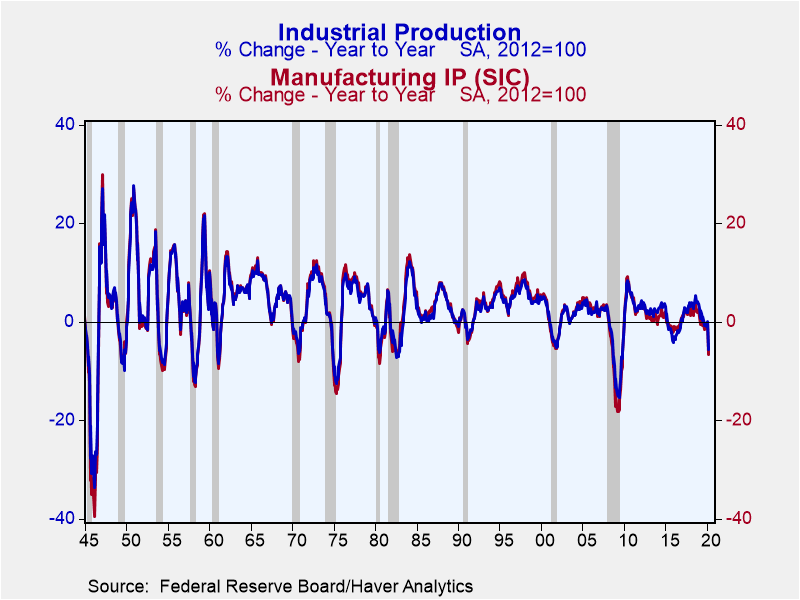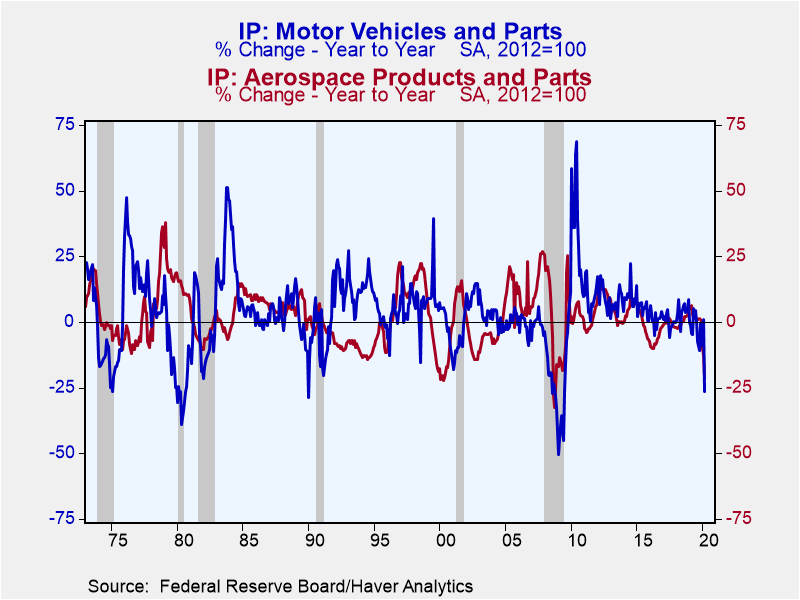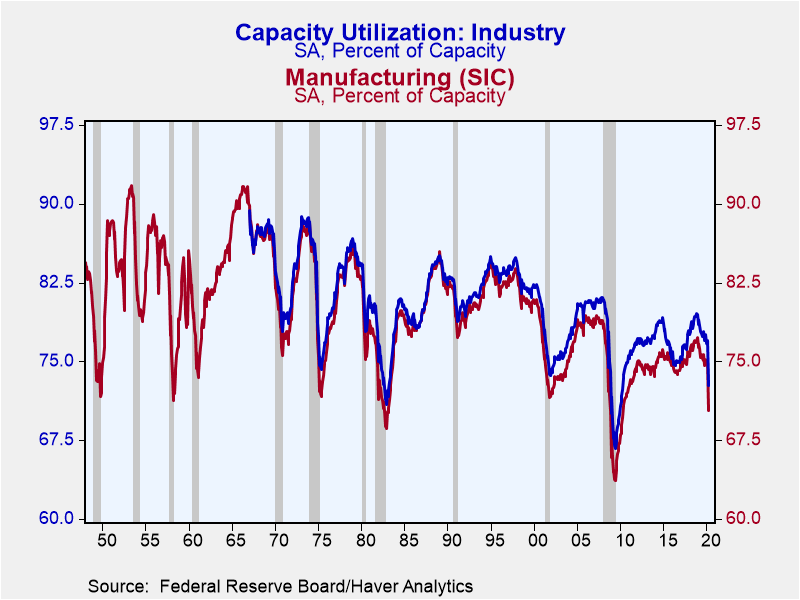 Global| Apr 15 2020
Global| Apr 15 2020Largest Drop in Industrial Production in 75 Years
Summary
• Industrial production fell 5.4% in March led by a 6.3% drop in manufacturing output. • These are the largest single monthly declines in these measures since September 1945, as wartime production ended. • Durable goods output dropped [...]
• Industrial production fell 5.4% in March led by a 6.3% drop in manufacturing output.
• These are the largest single monthly declines in these measures since September 1945, as wartime production ended.
• Durable goods output dropped a record 9.1% driven by a 28.0% collapse in motor vehicle output.
Industrial production plummeted 5.4% in March (-5.5% year-on-year). This is the largest single monthly decline since September 1945, when the U.S. was ending its World War II production surge. The Action Economics Survey forecast a 4.0% drop.
Manufacturing activity collapsed 6.3% (-6.6% y/y) during March. The last time factory output fell this much was also in September 1945. Utilities output declined 3.9% (-5.1% y/y) and mining activity decreased 2.0% (unchanged y/y). While large, these changes are not notable, because utility and mining activity show large month-to-month volatility as a result of variable weather and commodity prices.
Manufacturing of durable goods dropped a record 9.1% (-9.6% y/y) in March; this data as well as all sectoral data discussed below goes back to 1972. All major durable goods sectors were down, led by a 28.0% fall in motor vehicle production (-26.5% y/y); the largest monthly decline was 28.5% in January 2009 during The Great Recession. Aircraft production dived 9.0% on top of 737 MAX related declines in previous months and is now down 21.4% y/y. Machinery output fell an unprecedented 5.6% (-9.1% y/y).
Nondurable output decreased 3.2% (-3.1% y/y) - the all-time low is -3.8% - as double digit drops in textile, apparel and printing were offset by smaller cuts in food (-0.8%; +0.5% y/y) and chemicals (-1.7%; -3.4% y/y).
Output of business equipment, an indicator of capital spending, fell a record 8.6% in March (-12.6% y/y); data goes back to 1947. In the special aggregate groupings, production of high technology products edged down 0.1% (+5.5% y/y). Factory output excluding the motor vehicle, high tech, and energy sectors dived an unprecedented 4.5% (-5.1% y/y), and is now 15% below its 2007 peak; data goes back to 1967.
Capacity utilization fell to 72.7% from 77.0% - the largest monthly decline in history - to a 10 year low; data goes back to 1967.The Action Economics Survey expected 74.3% in March. Factory sector use dropped a record 4.7 percentage points to a 10-year low 70.3%. Data for capacity utilization goes back to 1967.
Industrial production and capacity are included in Haver's USECON database. Additional detail on production and capacity can be found in the IP database. The expectations figures come from the AS1REPNA database.
| Industrial Production (SA, % Change) | Mar | Feb | Jan | Mar Y/Y | 2019 | 2018 | 2017 |
|---|---|---|---|---|---|---|---|
| Total Output | -5.4 | 0.5 | -0.5 | -5.5 | 0.9 | 3.9 | 2.3 |
| Manufacturing | -6.3 | -0.1 | -0.1 | -6.6 | -0.2 | 2.3 | 2.0 |
| Durable Goods | -9.1 | 0.2 | -0.7 | -9.6 | 0.7 | 3.4 | 2.2 |
| Motor Vehicles | -28.0 | 3.2 | 1.4 | -26.5 | -2.4 | 4.1 | 0.0 |
| Selected High Tech | -0.1 | -1.0 | 1.5 | 5.5 | 5.1 | 6.4 | 2.6 |
| Nondurable Goods | -3.2 | -0.3 | 0.4 | -3.1 | -0.7 | 1.9 | 1.9 |
| Utilities | -3.9 | 7.0 | -4.7 | -5.1 | -0.8 | 4.4 | -0.8 |
| Mining | -2.0 | -1.3 | 0.6 | 0.0 | 7.1 | 12.4 | 7.4 |
| Capacity Utilization (%) | 72.7 | 77.0 | 76.7 | 78.4 | 77.8 | 78.7 | 76.5 |
| Manufacturing | 70.3 | 75.0 | 75.1 | 76.2 | 75.6 | 76.6 | 75.1 |
Gerald D. Cohen
AuthorMore in Author Profile »Gerald Cohen provides strategic vision and leadership of the translational economic research and policy initiatives at the Kenan Institute of Private Enterprise.
He has worked in both the public and private sectors focusing on the intersection between financial markets and economic fundamentals. He was a Senior Economist at Haver Analytics from January 2019 to February 2021. During the Obama Administration Gerald was Deputy Assistant Secretary for Macroeconomic Analysis at the U.S. Department of Treasury where he helped formulate and evaluate the impact of policy proposals on the U.S. economy. Prior to Treasury, he co-managed a global macro fund at Ziff Brothers Investments.
Gerald holds a bachelor’s of science from the Massachusetts Institute of Technology and a Ph.D. in Economics from Harvard University and is a contributing author to 30-Second Money as well as a co-author of Political Cycles and the Macroeconomy.









